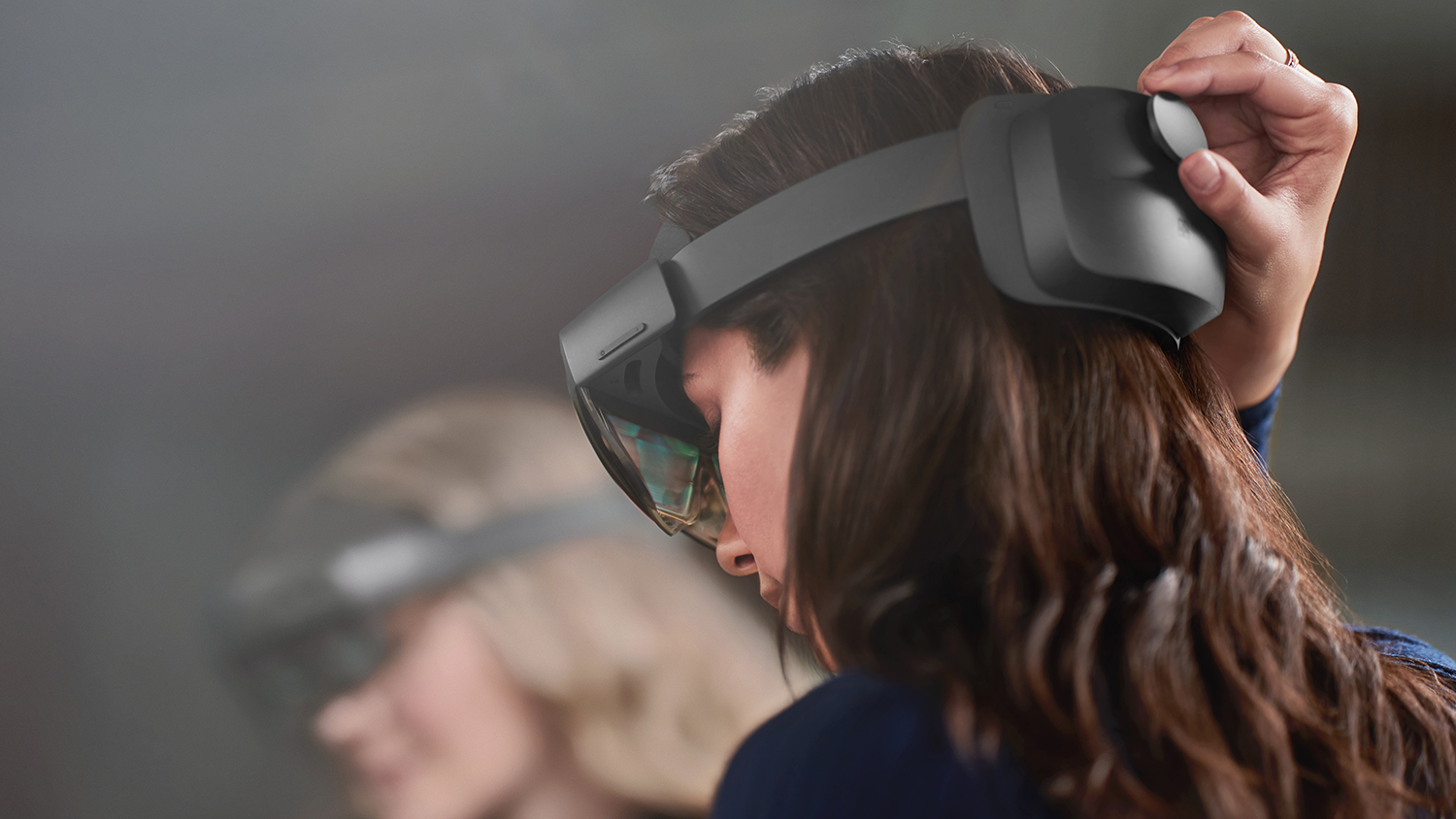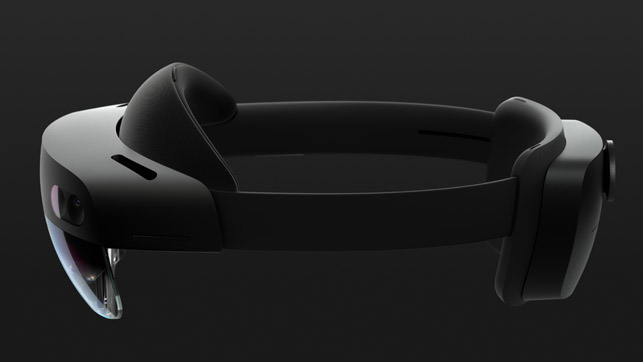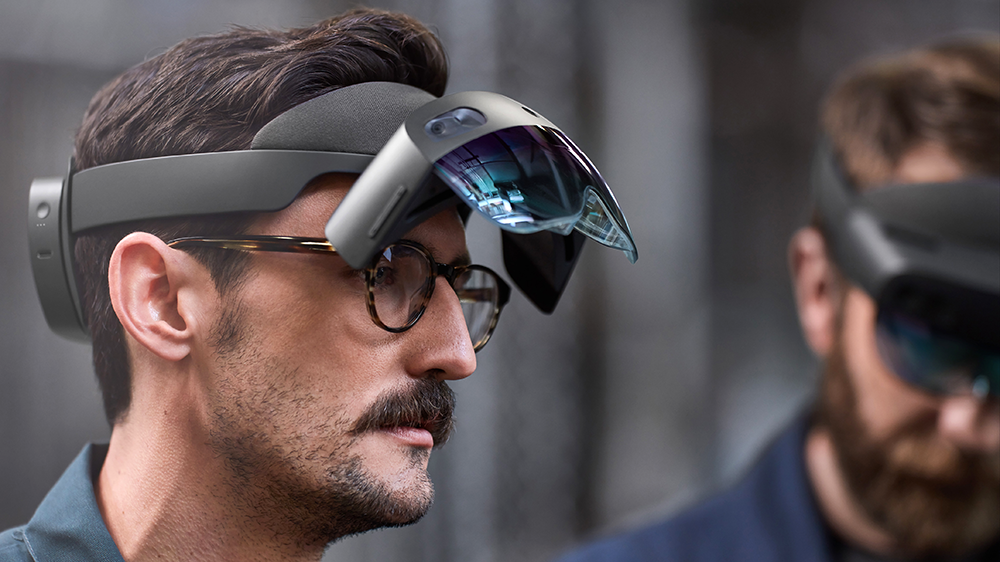HoloLens 2 – Microsoft has updated its mixed reality headset, releasing a more comfortable and engaging product – but its best trick is the Azure cloud connectivity that brings big data to the small screen
The second generation of Microsoft’s head mounted display (HMD) for mixed reality visualisation has arrived, with the foibles of its predecessor almost entirely worked out.
Microsoft has rebalanced the Hololens 2, distributing weight more evenly, making longer sessions possible before fatigure sets in
The previous design was weighty and cramped when used for long periods; the holographic display window was the size of a matchbox, requiring lots of head movement by the user in order to get the full picture; the promised software never really took root. HoloLens 2 significantly improves on its predecessor, by immediately shedding some bulk, rebalancing weight distribution and adding a flip-up visor.
The device is still untethered, but where there is still weight, this has shifted to the rear of the headband. As a result, we found there was less pull on the front of the head.
A fully redesigned headband now fits a wider range of head sizes and shapes, too, and we were able to put it on and fasten it more easily, with a single hand turning a dial at the back.
Improved thermal management, with a new ‘vapor chamber’ technology, should make it cooler to wear for lengthier sessions, but it’s the ‘welder’s mask’ flip-up visor that made the biggest difference during our demo, allowing us to switch between MR and actual reality quickly, and making donning the visor easier, especially for those who wear glasses.

The carbon fibre-reinforced materials and build quality look and feel more professional, which should help the headset stand out in the growing professional section of the market for virtual reality (VR), augmented reality (AR) and mixed reality (MR) products.
Even its accessories, such as the carry case, have a more ‘high end’ feel. But it’s what’s happening on the inside of the glass that matters most. The sense of immersion that the HoloLens 2 offers is greatly enhanced, thanks to both improved resolution, with a holographic density of 47 pixels per degree of sight, and an increased field of view now covered by the MR window that overlays the data.
According to Microsoft, this window has more than doubled in size and, as a result, the experience is more realistic and easier to navigate. Things like in-vision pop-up windows, which act like secondary screens, are more legible and usable, since they are no longer crammed into a small window directly in front.
HoloLens 2 contains a new 2k 3:2 light engine display system that enables significant performance improvement. We found that images and animations moved more smoothly, pixel density made for better realism and colours were more vibrant.
The way in which you interact with the device has changed quite dramatically. With natural hand tracking, there are 25 points of articulation per hand, for pinching, pulling and pressing. Gone are the weird air taps, and the result is a far more intuitive way of working.

HoloLens 2 meets CAD
Many use cases, for designers at least, will focus on repurposing 3D CAD data for down-the-line processes, such as shop floor manufacturing and assembly, and for reducing downtime with assisted maintenance, adding value to products by reusing CAD data that already exists.
PTC leads the line-up of CAD developers looking to produce native software for the HoloLens, with its Vuforia developer kit showcased at the launch of the device at the Mobile World Congress event in Barcelona, back in February.
PTC Vuforia’s tools allow for the easy transition of Creo CAD models into a wide range of AR and MR formats for different hardware, with custom mark-ups and sequences added using Creo Illustrate, keeping everything local and intuitive for the PTC user.
Dassault Systèmes is also listed by Microsoft as a software partner, with future applications most likely to be based around SolidWorks XR.
Theorem Solutions is also delivering applications to a variety of HMDs, including Hololens 2, interestingly, allowing users to connect to remote sessions with a variety of devices.
Unity also has a very important role here, since its 3D game engine, when paired with a plug-in from PiXYZ that optimises CAD data, can be used to create MR applications for HoloLens. Firms with Unity programmers can also create bespoke, workflow-based applications.
The range of complementary software is likely to increase further, thanks to the ability to connect HoloLens 2 directly to Microsoft’s Azure cloud service. (For more on Unity, click here.)
Cloud connectivity means the HMD can handle significantly larger models. With the previous HoloLens model, users were limited to what the device’s onboard GPU could render – about 200,000 to 300,000 polygons at 60 FPS. This meant it simply wasn’t possible to work with large 3D models at a high level of detail. Instead, the model had to be simplified or broken down into manageable chunks.
HoloLens 2 blows this challenge out of the water, with its ability to handle hundreds of millions of polygons. Rather than having to rely on the on-board GPU for graphics processing, the graphics can instead be processed remotely and streamed over WiFi and future 5G services via Azure Remote Rendering.
HoloLens 2 is available for pre-order starting at $3,500 for the device only.
Bundles are available, including the Development Edition, which combines HoloLens 2 with free trials of Unity software and Azure credits for cloud service, starting at $99 per month.






